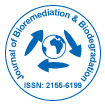Research Article
Biodegradation of Malachite Green by Klebsiella Terrigenaptcc 1650: The Critical Parameters Were Optimized Using Taguchi Optimization Method
| Ramezani S1*, Pourbabaee AA2 and Javaheri Daneshmand H3 | |
| 1Department of Chemistry, Tarbiat Moallem University, Tehran, Iran | |
| 2Department of Soil science, Biotech Lab, Tehran University, Tehran, Iran | |
| 3Department of Microbiology, Faculty of Science, Islamic Azad University, Qom Branch, Qom, Iran | |
| Corresponding Author : | Ramezani S Department of chemistry Tarbiat Moallem University Karaj, Iran E-mail: soleyman.ramezani@tmu.ac.ir |
| Received October 17, 2012; Accepted November 28, 2012; Published November 30, 2012 | |
| Citation: Pourbabaee AA, Ramezani S, Javaheri Daneshmand H (2013) Biodegradation of Malachite Green by Klebsiella Terrigenaptcc 1650: The Critical Parameters Were Optimized Using Taguchi Optimization Method. J Bioremed Biodeg 4:175. doi: 10.4172/2155-6199.1000175 | |
| Copyright: © 2013 Pourbabaee AA, et al. This is an open-a ccess article distributed under the terms of the Creative Commons Attribution License, which permits unrestricted use, distribution, and reproduction in any medium, provided the original author and source are credited. | |
Related article at Pubmed Pubmed  Scholar Google Scholar Google |
|
Abstract
In the work ahead, the microbial degradation of Malachite Green (MG) was investigated by the bacterium
Klebsiella. At first, the Taguchi Optimizing Method (TOM) was used to optimize the experimental conditions. 16 introduced states were tested by the L-16 array type of the software and each case was repeated three times for calculating signal/noise (S/N) ratio. Based on S/N ratio, it was found that, the best experimental conditions will be at the dye concentration of (25 ppm), temperature (30°C), pH (~6), carbon source (Lactose) and nitrogen source (Ammonium nitrate). After reviewing the obtained results of Taguchi software, were found that, initial dye concentration and nitrogen source are most and less effective in the MG degradation experiments respectively. For experimental study, the MSM (Mineral Salt Medium) with phosphate buffers (for pH of 6, 6.6 and 7), Tris tampons (for pH of 6.7, 8 and 4.8) and acetic acid/sodium acetate tampons (for pH of 5 and 6.5) were used. For chemical analysis, dichloromethane was used as organic solvent. Eventually, UV-Visible absorption spectrum, HPLC and FTIR analysis confirmed completely degradation of MG by the bacterium Klebsiella.

 Spanish
Spanish  Chinese
Chinese  Russian
Russian  German
German  French
French  Japanese
Japanese  Portuguese
Portuguese  Hindi
Hindi 
